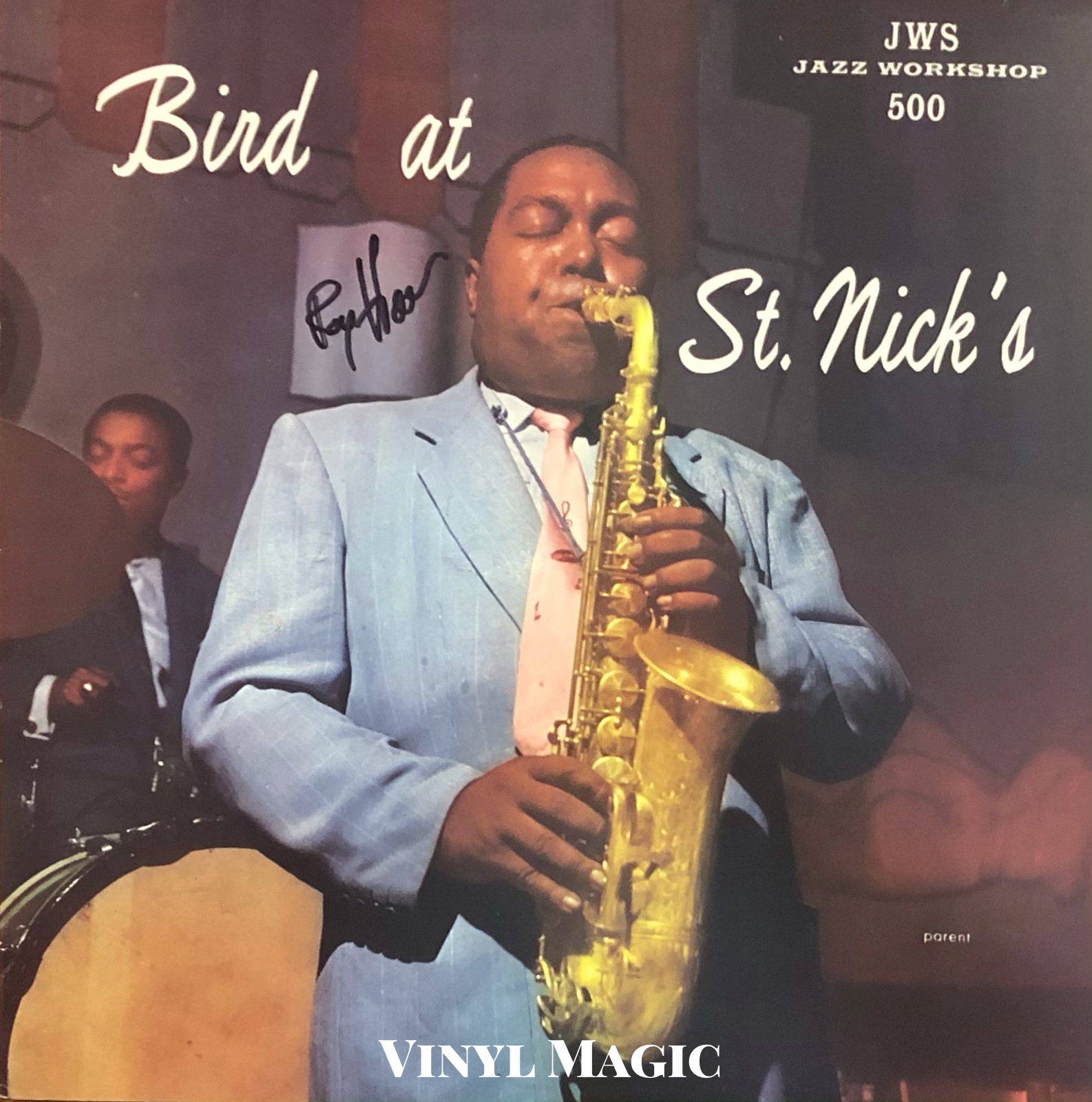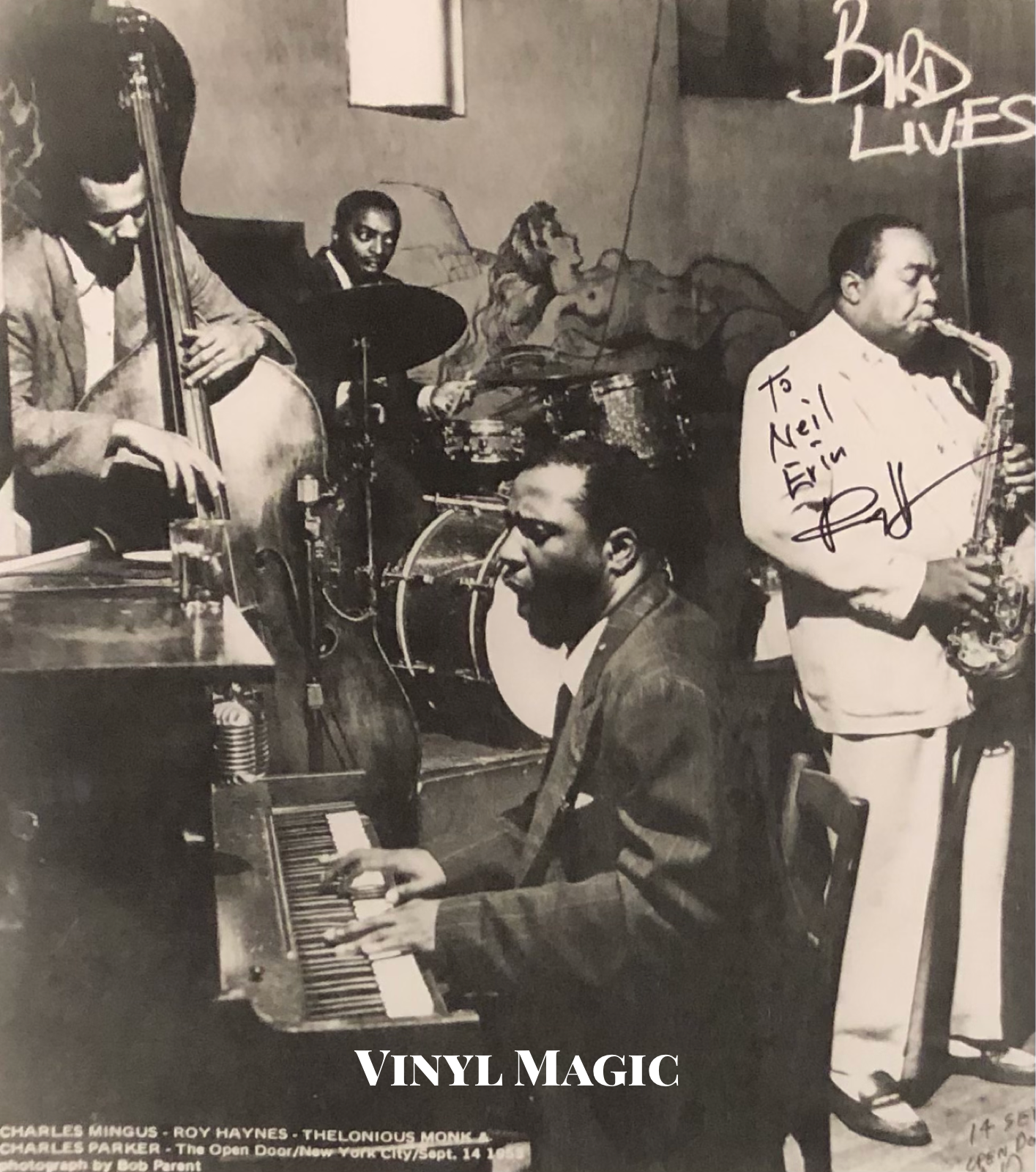Charlie Parker, Roy Haynes and Me...
Well, ever since I can remember, I was banging. I was playing on things. Rhythm. Listening to a lot of music. On the radio… they had good radio stations in Boston.
Roy Haynes
Bird At St. Nick’s (1950 recordings) signed by Roy
Charlie Parker never really told me what or how to play. That’s one of the things you sometimes find with that type of genius—more so than today: Everyone now is ready to tell you what to play. Everyone wants to tell drummers what to do. Fortunately, that doesn’t concern me much, because I prefer to do my own projects. The only thing I remember Charlie Parker telling me, if we were playing a big hall, was, ‘Keep it down at first until you get the feeling of the room.’ Other than that, we just played. I would listen—just grasp. You have to be on the stand and play drums, especially when you play with a lot of different people.
Roy Haynes
Bird Lives - Monk, Mingus, Parker and Haynes at the Open Door, NYC photo by Bob Parent, signed by Roy
The room was a basement that had good live sound, especially for a room with a low ceiling. Because it was named Birdland, after Charlie Parker, they had live birds in cages when it first opened up. All the birds died from so much smoke and no sun. I had a lot of great nights there: opening up with Bird, of course, playing there in the ’60s with Coltrane, and also performing with my own groups. One of my highlights was playing there with my trio featuring Phineas Newborn. He was all over that piano. Phineas had that rhythm thing—very percussive. The notes were sharp—hittin’. It gave me something to play with. We played well together; we had a nice rapport. But the years I remember about Birdland with the most fondness were the ’40s and ’50s. During that time, there was a lot of love. Playing in New York then was like a dream.
Roy Haynes
We Three (1958) signed by Roy
I happened to be at 126th Street and Eighth Avenue. That’s where all the greatest musicians in the world would be. I used to go there to see buddies. A lot of bands used to leave from there at the Hotel Braddock—big bands. Armstrong’s bus was there ready to leave, and I happened to have time off from Luis Russell’s band. I left with Armstrong, and went down South to play in tobacco warehouses and places like that. All you had to do was swing, man, and play with some feeling—back up the solos and shade. Playing loud and soft was called shading. Most of it came naturally to me. I had ears. I could hear anything.
Roy Haynes
The Sound Of Sonny (1957) signed by Roy, Sonny Rollins, Percy Heath
Younger drummers who never got to see Papa Jo play missed the treat of their lives… Jo Jones had a feeling—a looseness. He had a happy sound. He was something to watch, especially with a big band like Basie’s. That was it! When I was about 16 years old, I would go to the RKO theater in Boston to see him. When he started his solo, it was something special—different. It wasn’t about playing fast. It was that warm sound. He ‘ invented ‘ the sock cymbal. The way he played it was beautiful to listen to and watch. He didn’t have to play a solo; just a two-bar break was beautiful.
Roy Haynes
Portrait Of Art Farmer (1958) signed by Art, Roy, Hank Jones
Roy Haynes is one of the best drummers I’ve worked with. I always tried to get him when Elvin Jones wasn’t able to make it. There’s a difference between them. Elvin’s feeling was a driving force. Roy’s was more of a spreading, a permeating. Well, they both have a way of spreading the rhythm, but they’re different. They’re both very accomplished. You can feel what they’re doing and can get with it.
John Coltrane
Tales Of Manhattan (1958) signed by Roy
I deal with sounds. I’m full of rhythm, man. I feel it. I’m thinking summer, winter, fall, spring, hot, cold, fast and solo, and colors. But I don’t analyze it....and I just keep it moving, and spread the rhythm, as Coltrane said. Keep it moving, keep it crisp.
Roy Haynes
Live At The Five Spot (1959) signed by Roy, Randy Weston
A jazz drummer virtuoso, Roy Haynes was born in Boston in 1925. He started with Lester Young in the 1940s, joined Charlie Parker in the early 1950s, and played with nearly every significant jazz artist, including Miles Davis, John Coltrane, Charles Mingus, Thelonious Monk and Art Pepper. Slight of build, but incredibly propulsive behind his drum kit, Roy earned the nickname "Snap Crackle." And he still does.
Man At Work (1959) signed by Kenny Burrell, Richard Davis, Roy
I saw Roy many times over the years at jazz clubs in New York City like the Blue Note, the Village Vanguard, and Birdland, and he was always generous in signing albums. Once, I brought him a poster to sign which has probably the best jazz quartet ever, a photograph by Bob Parent at the Open Door Cafe in New York City in September, 1953. Charlie Parker is blowing alto saxophone, Charles Mingus is playing bass, with Thelonious Monk on piano, and Roy on drums. When Roy saw the picture, he was taken aback. "Where did you get this? This brings back some great memories." Sheepishly, I told him I bought it from a New York City sidewalk street vendor. "I'd love to get a copy. Let me give you my address if you ever find another copy. You can mail it to me." Roy scrawled out his address which I happily received. I told him I would do my best to track down the poster, but I would need some help. Tracking down an itinerant street vendor would take considerable sleuthing and skill. Or luck.
Roy’s address, late 1990s
Moodsville (1960) signed by Roy, Tommy Flanagan
I got lucky several months later when I saw the poster displayed with a different vendor in Greenwich Village and bought a copy. When Roy played Birdland six months later, I went to see him and gave him the poster. Roy was so grateful to have a picture with Charlie Parker with whom he had played for three amazing years - The Greatest Jazz Quartet ever with Monk, Mingus, Parker and Haynes, all titans in jazz.
Destination…Out! (1963) signed by Roy, Jackie McLean
We spent some time looking at records of other artists Roy played with like Art Farmer, Sonny Rollins, Kenny Burrell, Randy Weston, et al. It is an impressive roster of seminal jazz artists and recordings. And versatile, from swing to bebop to fusion to avant garde. During his nearly seventy-five year professional career, Roy has played on hundreds of sessions and recordings, and he has been the leader on over thirty albums. Well into his 90th year, Roy continues to play and evolve. One of his latest recordings as a leader is with his aptly named Fountain Of Youth (2004) band. As Roy said recently, "When you're a serious artist, you don't think about how old you are. We all become the same age on the bandstand."
Roy Haynes, a drummer's drummer who keeps it moving and crisp. The snap crackle never sounded better.
All The Things We Are (1974) signed by Roy, Dave Brubeck, Lee Konitz
Times Square (1978) signed by Roy, Gary Burton, Steve Swallow
Trio Music (1982) signed by Roy, Chick Corea, Miroslav Vitous
Choice Roy Haynes Cuts (per BKs request)
https://www.youtube.com/watch?v=cGILJx8n9ug
“Repetition” live with Charlie Parker 1952
https://www.youtube.com/watch?v=4LrF-Lcyh5Y
“After Hours” We Three 1959
https://www.youtube.com/watch?v=gTAMZS-kaMU
“Fly Me To The Moon” Out Of The Afternoon 1962
https://www.youtube.com/watch?v=7kXWHd0K9OA
“Blue n Boogie” Charlie Parker tribute 1973
https://www.youtube.com/watch?v=07HBRUwPj7I
“Jive Hoot” live with Stan Getz 1966
https://www.youtube.com/watch?v=VCzRXyZL_hc
“Groovin’ High” live at White House with Dizzy Gillespie, Stan Getz
https://www.youtube.com/watch?v=PHGqP3GBhXQ
“Quiet Fire” Thank You Thank You 1977
https://www.youtube.com/watch?v=nuXBMFrpWDc
“Round Midnight” Summit Meeting At Birdland 1951
https://www.youtube.com/watch?v=HaJiMfcoYao
“Go n Git It!” Cymbalism 1963
https://www.youtube.com/watch?v=vDZ34WUF4PE
“Like Someone In Love” All The Things We Are 1974
Thank You Thank You (1977) signed by Roy, George Cables
Blues For Coltrane (1988) signed by Roy, McCoy Tyner, Pharoah Sanders, Cecil McBee
Question & Answer (1990) signed by Roy

















